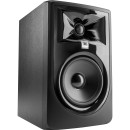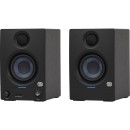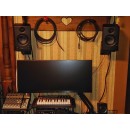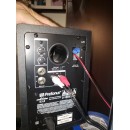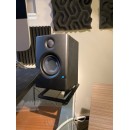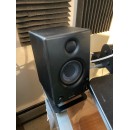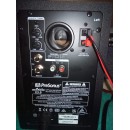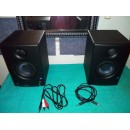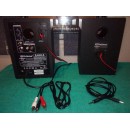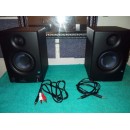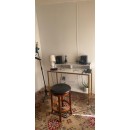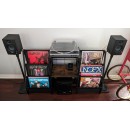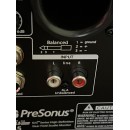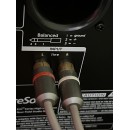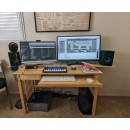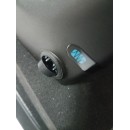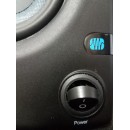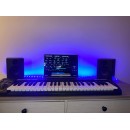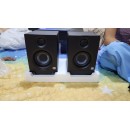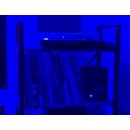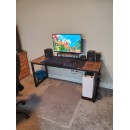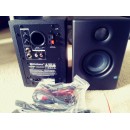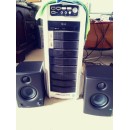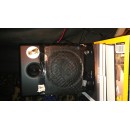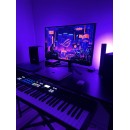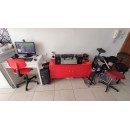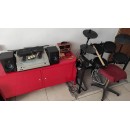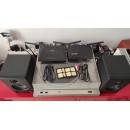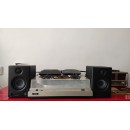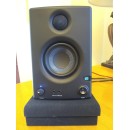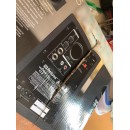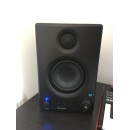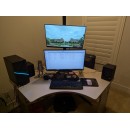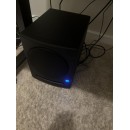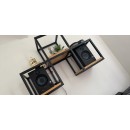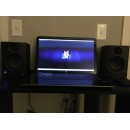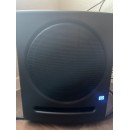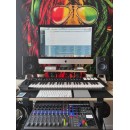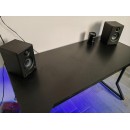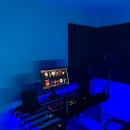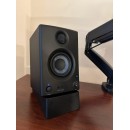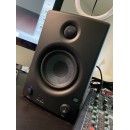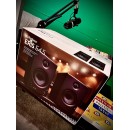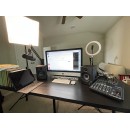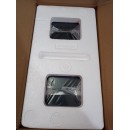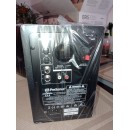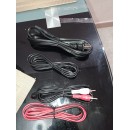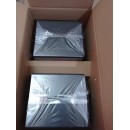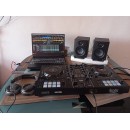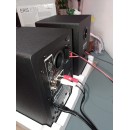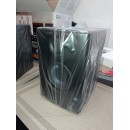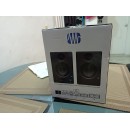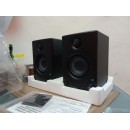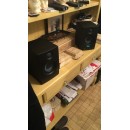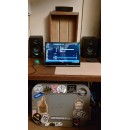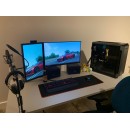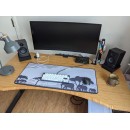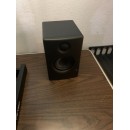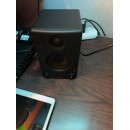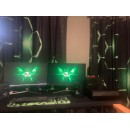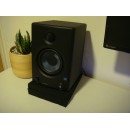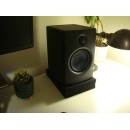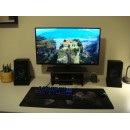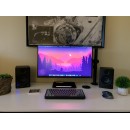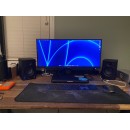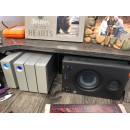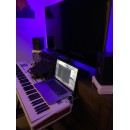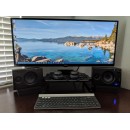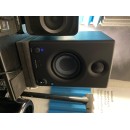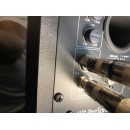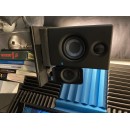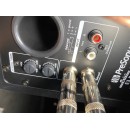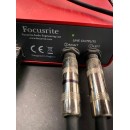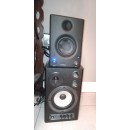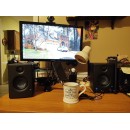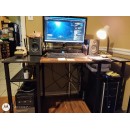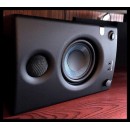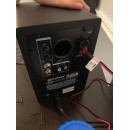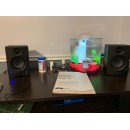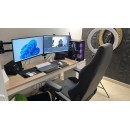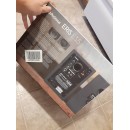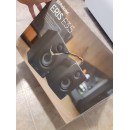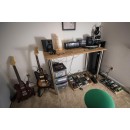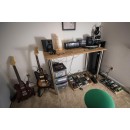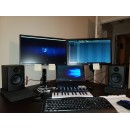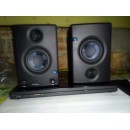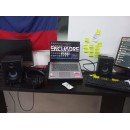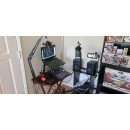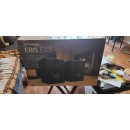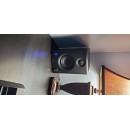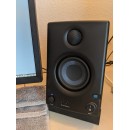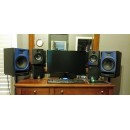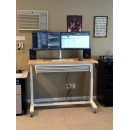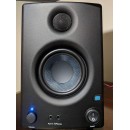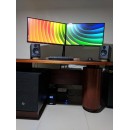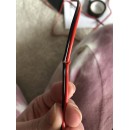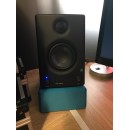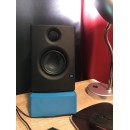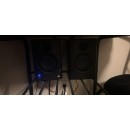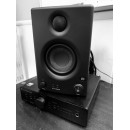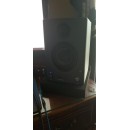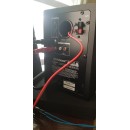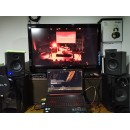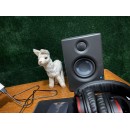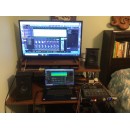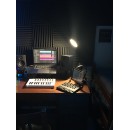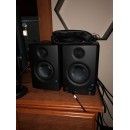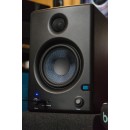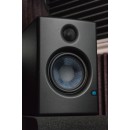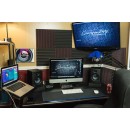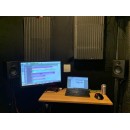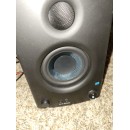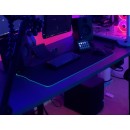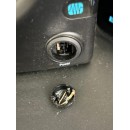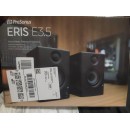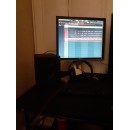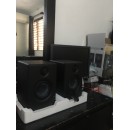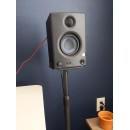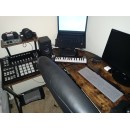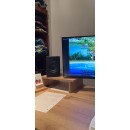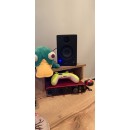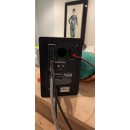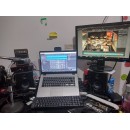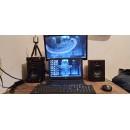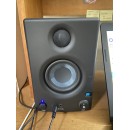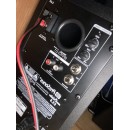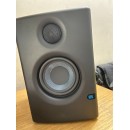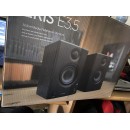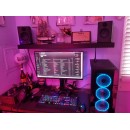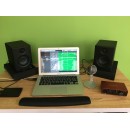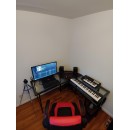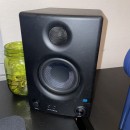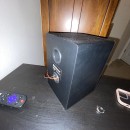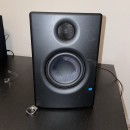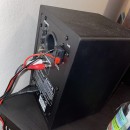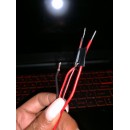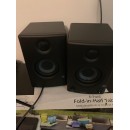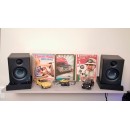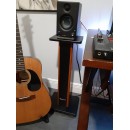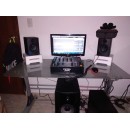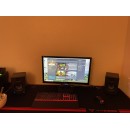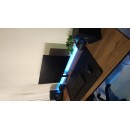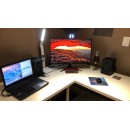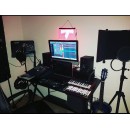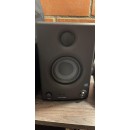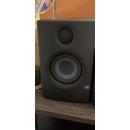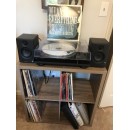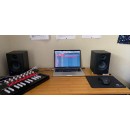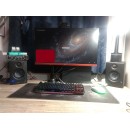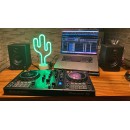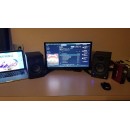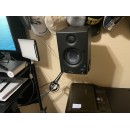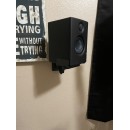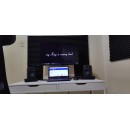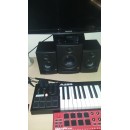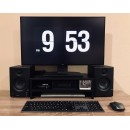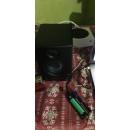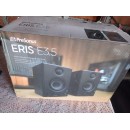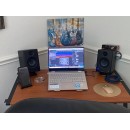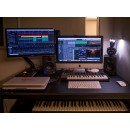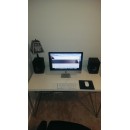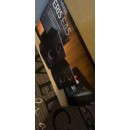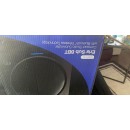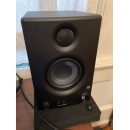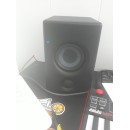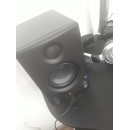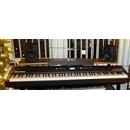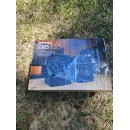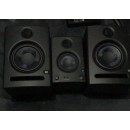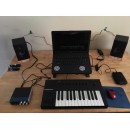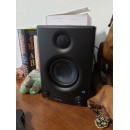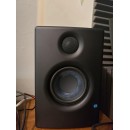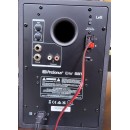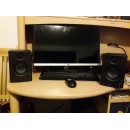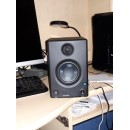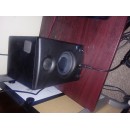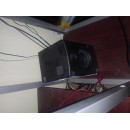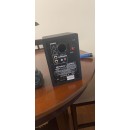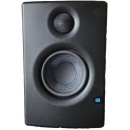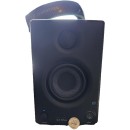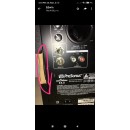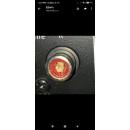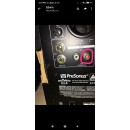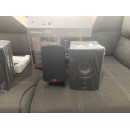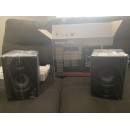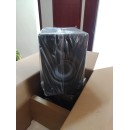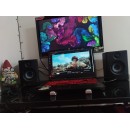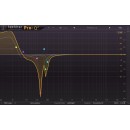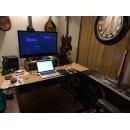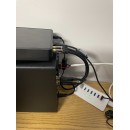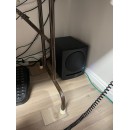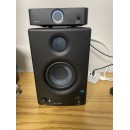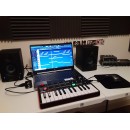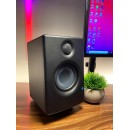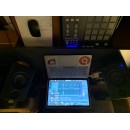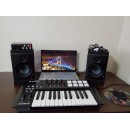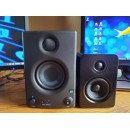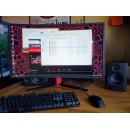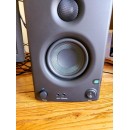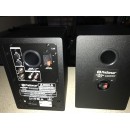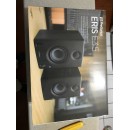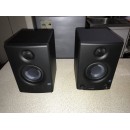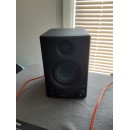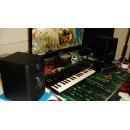PreSonus ERIS 3.5 vs JBL 305P MkII: Which Studio Monitor is Right for You?
The PreSonus ERIS 3.5 Studio Monitor Speaker and the JBL 305P MkII Studio Monitor Speaker are both designed to deliver high-quality sound, yet they cater to slightly different needs and budget points. The PreSonus ERIS 3.5 is a compact and affordable option, ideal for beginner producers or those who need a budget-friendly solution for their home studio. It features a 3.5-inch woofer and a 1-inch silk-dome tweeter, which together provide a balanced frequency response, although its bass output might not be as powerful due to its smaller woofer size. It includes front-panel controls for volume, as well as high and low-frequency tuning options, allowing users to adjust the sound to their preference or room acoustics.
In contrast, the JBL 305P MkII is part of JBL's professional-grade studio monitor line, offering a more robust and refined audio experience. It is equipped with a 5-inch woofer and a 1-inch neodymium tweeter, which are powered by dual integrated Class-D amplifiers. This model is known for its exceptional imaging and detail, thanks to its innovative Image Control Waveguide technology. This feature delivers a broad sweet spot and precise soundstage, making it an excellent choice for critical listening and mixing tasks. The JBL 305P MkII also provides more extensive connectivity and tuning options, including boundary EQ and HF trim controls, allowing for better room integration and sound customization.
Overall, when comparing these two models, the PreSonus ERIS 3.5 is a great entry-level monitor with a focus on affordability and simplicity, suitable for casual listening or basic home studio setups. On the other hand, the JBL 305P MkII caters to professionals or serious enthusiasts who require higher fidelity and more advanced features for accurate mixing and mastering. The choice between these monitors should be based on your specific needs, budget, and the level of audio precision you desire in your studio environment.
In the following sections, we will dive deep into the specifications, advantages, and disadvantages of the PreSonus ERIS 3.5 and JBL 305P MkII studio monitor speakers. Our thorough examination will provide you with all the necessary insights to understand these products better and help you decide which one suits your needs best.
Specification Comparison and In-Depth Analysis
| User Rating Based on Analysis of Reviews | |
|---|---|
|
Show More |
| Pros: | |
|---|---|
|
|
| Cons: | |
|---|---|
|
|
| Key Specs | |
|---|---|
| Monitor Type & Configuration | |
| Active 2-Way | Active 2-Way |
| Total Power Output | |
| 82 W | 25 W RMS per Monitor |
| Tweeter | |
| 1x 1" / 25.4 mm Dome | 1x 1" / 25.4 mm Silk Dome |
| Woofer | |
| 1x 5" / 12.7 cm Cone |
1x 3.5" / 11.4 cm Cone |
| Frequency Range | |
| 43 Hz to 24 kHz (-10 dB) | 80 Hz to 20 kHz |
| Audio I/O | |
| 1x XLR 3-Pin Balanced Line Input 1x 1/4" TRS Balanced Line Input |
2x 1/4" TRS Balanced Input 1x Stereo 2RCA Unbalanced Input 1x 1/8" / 3.5 mm TRS Unbalanced Input 2x Binding Post Pair Output 1x 1/8" / 3.5 mm TRS Headphone Output |
| Digital Audio I/O | |
| Network I/O | |
| Wireless | |
The PreSonus ERIS 3.5 Studio Monitor Speaker is an active 2-way monitor with a total power output of 25 W RMS per monitor. It features a 1-inch silk dome tweeter and a 3.5-inch cone woofer, providing a frequency range from 80 Hz to 20 kHz. This model is designed for nearfield monitoring and is suitable for small studio environments, offering a compact design that makes it easy to integrate into limited spaces.Show More
In contrast, the JBL 305P MkII Studio Monitor Speaker also boasts an active 2-way configuration but delivers a significantly higher total power output of 82 W. It comes equipped with a 1-inch dome tweeter and a 5-inch cone woofer, which extends its frequency response down to 43 Hz and up to 24 kHz (-10 dB). This monitor is better suited for larger studio setups due to its enhanced power and broader frequency response, providing a more dynamic sound experience.
When it comes to audio inputs, the PreSonus ERIS 3.5 offers a versatile range, including 2x 1/4" TRS balanced inputs, 1x stereo 2RCA unbalanced input, and a 1/8" TRS headphone output. The presence of binding post outputs allows for additional connectivity options. On the other hand, the JBL 305P MkII provides 1x XLR 3-pin balanced line input and 1/4" TRS balanced line input, focusing more on professional audio connections.
Overall, while both monitors are excellent choices for studio monitoring, the PreSonus ERIS 3.5 is ideal for smaller setups and budget-conscious users, while the JBL 305P MkII is geared towards professionals seeking greater power and extended frequency response.
| General | |
|---|---|
| Number of Included Monitors | |
| Single Monitor | Stereo Pair |
| Enclosure | |
| Bass-Reflex/Ported, Shielded | Bass-Reflex/Ported |
| Total Power Output | |
| 82 W | 25 W RMS per Monitor |
The PreSonus ERIS 3.5 Studio Monitor Speaker comes as a stereo pair, making it an excellent choice for those looking to set up a budget-friendly home studio without sacrificing quality. Each monitor has a total power output of 25 W RMS, providing a decent sound level suitable for personal use. The enclosure is designed as a bass-reflex/ported type, enhancing low-frequency response, although it may not match the power and clarity of larger studio monitors.Show More
In contrast, the JBL 305P MkII is a single monitor that significantly outperforms the PreSonus in terms of power, with a total power output of 82 W. This model features a 1-inch dome tweeter and a 5-inch cone woofer, which contribute to its robust sound quality. The frequency range extends from 43 Hz to 24 kHz (-10 dB), with a frequency response of 49 Hz to 20 kHz ± 3 dB, indicating a wider and more accurate reproduction of sound compared to the PreSonus model.
Moreover, the JBL monitor boasts a maximum sound pressure level (SPL) of 108 dB and a signal-to-noise ratio of 75 dBA, ensuring clarity and detail in audio playback. The total harmonic distortion (THD) is remarkably low at < 0.2%, providing cleaner sound. Additionally, it features a peak limiter for protection, customizable EQ settings for high and low frequencies, and a sophisticated Linkwitz-Riley crossover at 1725 Hz, allowing for precise sound management.
Overall, while the PreSonus ERIS 3.5 Studio Monitor Speaker is an excellent entry-level option for casual listeners or beginners, the JBL 305P MkII provides enhanced performance, making it a superior choice for serious audio professionals seeking detailed and powerful sound reproduction.
| Connectivity | |
|---|---|
| Audio I/O | |
| 1x XLR 3-Pin Balanced Line Input 1x 1/4" TRS Balanced Line Input |
2x 1/4" TRS Balanced Input 1x Stereo 2RCA Unbalanced Input 1x 1/8" / 3.5 mm TRS Unbalanced Input 2x Binding Post Pair Output 1x 1/8" / 3.5 mm TRS Headphone Output |
| Digital Audio I/O | |
| Network I/O | |
| USB | |
| Wireless | |
| Mobile App Compatible | |
The PreSonus ERIS 3.5 Studio Monitor Speaker offers versatile audio connectivity with a total of four input options. It includes 2x 1/4" TRS Balanced Inputs, 1x Stereo 2RCA Unbalanced Input, and a convenient 1/8" / 3.5 mm TRS Unbalanced Input. Additionally, it features 2x Binding Post Pair Outputs for speaker connections and a 1/8" / 3.5 mm TRS Headphone Output, making it an excellent choice for those who require multiple input sources and headphone monitoring capabilities.Show More
In contrast, the JBL 305P MkII Studio Monitor Speaker has a more streamlined input configuration. It includes a 1x XLR 3-Pin Balanced Line Input and a 1/4" TRS Balanced Line Input. While it is designed to provide high-quality audio monitoring, it lacks the variety of input options found in the PreSonus model, which may limit its versatility in certain studio setups.
Both monitors do not feature digital audio I/O, network I/O, USB connectivity, or wireless capabilities, nor are they mobile app compatible. This places them at a similar level in terms of modern connectivity options, making them suitable for users who prefer traditional wired connections for their audio needs.
| Physical | |
|---|---|
| Color | |
| Black | Black |
| Monitor Orientation | |
| Vertical | Vertical |
| Dimensions (W x H x D) | |
| 7.3 x 11.7 x 9.1" / 185.4 x 297.2 x 231.1 mm | 5.5 x 8.3 x 6" / 139.7 x 210.8 x 152.4 mm (Each) |
| Weight | |
| 10.4 lb / 4.7 kg | 3.1 lb / 1.4 kg (Pair) |
The PreSonus ERIS 3.5 Studio Monitor Speaker is designed with a compact form factor, measuring 5.5 x 8.3 x 6 inches and weighing only 3.1 lb per pair. This lightweight design makes it an ideal choice for smaller studio spaces or for those who require portability. Its vertical monitor orientation allows for easy integration into various setups, maintaining an efficient use of space.Show More
In contrast, the JBL 305P MkII Studio Monitor Speaker boasts a larger build, with dimensions of 7.3 x 11.7 x 9.1 inches and a weight of 10.4 lb per pair. The additional weight and size contribute to a more substantial acoustic performance, catering to users who may have more room in their studio environment. Like the PreSonus model, it also features a vertical orientation, enhancing its compatibility with typical studio arrangements.
Both speakers share a sleek black color scheme, fitting well into any studio aesthetic. However, the JBL 305P MkII is constructed from a combination of ABS and MDF, which may provide enhanced durability and resonance control compared to the materials used in the PreSonus ERIS 3.5. Additionally, the JBL model does not include mounting points, which could be a consideration for users looking to optimize their setup with wall mounts or other hardware.
| Packaging Info | |
|---|---|
| Package Weight | |
| 12.55 lb | 8.785 lb |
| Box Dimensions (LxWxH) | |
| 14.8 x 10.2 x 2.5" | 15.4 x 11.5 x 8.9" |
When comparing the PreSonus ERIS 3.5 Studio Monitor Speaker and the JBL 305P MkII Studio Monitor Speaker, one notable difference is the package weight. The PreSonus ERIS 3.5 weighs 8.785 lb, while the JBL 305P MkII is heavier at 12.55 lb. This difference in weight may influence portability and ease of setup, especially for users who need to transport their monitors frequently.Show More
In terms of box dimensions, the PreSonus ERIS 3.5 measures 15.4 x 11.5 x 8.9 inches, while the JBL 305P MkII has more compact dimensions of 14.8 x 10.2 x 2.5 inches. The larger dimensions of the PreSonus may provide a more substantial build, possibly affecting acoustic performance, while the JBL's smaller profile can be advantageous for tight spaces.
Overall, the differences in weight and dimensions between the PreSonus ERIS 3.5 and JBL 305P MkII studio monitors highlight considerations for users regarding portability and placement in various environments. Each option presents unique characteristics that may cater to different needs based on the user's setup and preferences.
| Customer Images | |
|---|---|
| Videos | |
|---|---|
|
|
|
